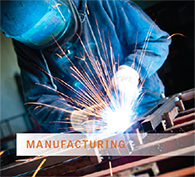The Importance of Data Analytics for Decision Making How can you stay informed? Data analytics…

FORECAST FOR 2016 – Construction Equipment Marketing
AFTER SEVERAL YEARS OF GRADUAL PROGRESS, THE ECONOMIC STARS ARE ALIGNING IN FAVOR OF A MORE ROBUST COMMERCIAL ENVIRONMENT.
(The economy is booming, be sure you focus on the markets that are growing. Take Donald Trump’s advice, “Don’t get into an industry in decline.” Or don’t make the mistake we did, getting into Green Building Marketing right at the downturn. No problem, now we’re prepared. Chuck Lohre)
By Phillip Perry, The Electrical Distributor Magazine (TED) Dec 2016
“WE EXPECT 2016 WILL BE A GOOD YEAR, WITH INCREASED consumer spending driving economic growth,” said Sophia Koropeckyj, managing director of industry economics at the research firm Moody’s Analytics. Why the sunny outlook? Economists point to a number of conditions favoring businesses: Higher employment, lower consumer debt, greater credit availability, and trimmed gasoline prices all lead to a more robust American economy. All should do their part to help en – courage stronger growth over the coming 12 months.
 RETAIL
RETAIL
Performance in the retail sector is a critical driver for the American economy in general—and one in which economists see an improving picture in 2016. “We expect core retail sales to grow 5.5% in 2016,” said Scott Hoyt, senior director of consumer economics for Moody’s Analytics. That growth rate is notably faster than the 4.2% rate anticipated when 2015 sales are finally tallied. The 2015 experience was slightly better than the 3.9% growth of 2014. If Moody’s Analytics is accurate in its forecast, businesses can rejoice, as the anticipated rate is not that far off the roughly 6% increases retailers commonly enjoyed during the robust decade of the 1990s—as well as the period they fondly remember just prior to the Great Recession. What will drive the anticipated retail sales increase? Primarily higher wages, fueled by the growing number of people gainfully employed.
 HOUSING
HOUSING
Businesses depend on a healthy economy to support strong sales. And one of the most important drivers of that is a robust housing construction sector that employs more people and generates more disposable income. “The ever-tightening market for new homes will likely spur stronger construction activity in 2016,” said Sophia Koropeckyj, managing director of industry economics at Moody’s Analytics. Indeed, housing starts are expected to rise 29.5% for the year, a considerable improvement over the 14.5% figure expected for 2015 when final numbers are tallied. (The rate for 2014 was 5.8%.) Why the spike in construction? According to Koropeckyj, the nation’s inventory of new homes has been falling steadily to the point where builders are now expected to perceive solid economic benefits in gearing up into higher production. The decline in inventory over the past year came about as builders held back from constructing new homes, concerned that consumer demand had not met expectations. That demand, in turn, was soft because, said Koropeckyj, “many young families saddled with mountains of student debt were opting to continue renting.” Granted, some conditions will have to be met before the housing rebound occurs. “The tightening housing market by itself does not guarantee a resumption of singlefamily construction,” noted Koropeckyj. “Household debt burdens will still have to fall significantly before buyers of new homes start to return to the market in strength. Even so, the U.S. recovery, with some outside help from low gasoline prices and consequently low inflation, is pulling that date forward.” The expected housing rebound should have a related effect: Home prices are expected to increase by only 2.9% in 2016, a deceleration of the 6.3% expected for 2015.
 MANUFACTURING
MANUFACTURING
Of special importance to all businesses is the performance by one subset of the larger corporate world: manufacturers. Any growth in that sector has a dramatic effect on employment—and therefore on the economy in general—because manufacturing is heavily dependent on a skilled labor force. It seems that manufacturers are looking ahead to a 2016 that will match or exceed what has been a reasonably good 2015. “Conditions are positive but not robust or booming,” said Tom Palisin, executive director of the Manufacturers’ Association (mascpa.org). “Manufacturers are doing slightly better than they were a year ago. They are reporting low to moderate growth, solid orders, and a good backlog.” Low energy prices are favorable for the sector. Looking to 2016, Palisin said, “Members are cautiously optimistic.” A telling indicator of that optimism is a new initiative to bolster the workforce. “One significant change is a move by many companies to invest more in their training budgets,” said Palisin, adding that manufacturers are doing so in response to a number of conditions: an improving economy, several years of cost cutting that has led to a lean workforce, and a lack of available skilled talent combined with low unemployment. “Employers now seem more eager to retain the employees they have by investing in training of their existing workforce,” Palisin added. That will translate into higher salaries and still more disposable income in consumers’ wallets. Manufacturers will be helped by a growing availability of credit, which has loosened considerably since the tight years of the Great Recession. “Rates are low and banks are willing to invest,” said Palisin. “However, there has not been much demand for commercial loans because many companies have sufficient cash on hand to finance their growth needs.” Others, he said, have delayed capital investment due to economic uncertainty and a tough regulatory environment.
LABOR
The most important contributing factor to a more robust marketplace, said Koropeckyj, is the growing health of the labor force. “Wage gains are now materializing across a number of industries and regions,” she said, noting that consumers will have more disposable cash to spend. Moody’s reported that unemployment fell to 5.1% in late 2015, a full percentage point decline over the level 12 months previous and a rate nearly identical to the 5% economists believe represents a condition of “full employment.” “While there is still slack in the labor market, it is declining quickly,” said Scott Hoyt, senior director of consumer economics for Moody’s Analytics. “At some point in 2016 the labor market should become tight, which should translate into faster growth in wages and consumer spending.” Indeed, Moody’s expects the nation to reach full employment by mid-2016 and the average unemployment rate during the fourth quarter of that year to be 4.8%. Gains in employment nationwide have helped create a population more confident of the future – and therefore more prone to spend. “Consumers have been feeling reasonably well,” said Walter Simson, principal of Ventor Consulting. Economists expect consumer confidence to continue to rise over the coming 12 months in response to a brighter employment picture.
A STRONGER ECONOMY
So just how good is “good” for 2016? That depends on how much consumers and businesses spend nationwide on goods and services. The faster the rise in that figure—the GDP—the healthier the economy. For 2016, Moody’s expects GDP to grow 3.25%. That’s considerably higher than the expected 2015 rate of 2.5%. The 2015 results, to be confirmed when the year’s sales numbers are tallied, were just slightly higher than 2014’s 2.43% growth rate. One big driver of the rise in GDP is expected to be an improving performance by large employers. Businesses of all sizes benefit when major corporations rack up healthy profits. Good earnings stimulate business expansion and an attendant investment in buildings and equipment. That generates still more business for suppliers, along with more employment and disposable income for consumers. In this area, again, the future looks rosy. “Corporate profit growth is expected to accelerate some 9.2% through 2016,” said Koropeckyj. That’s a considerable improvement over the results for 2015, when profits actually declined slightly as a result of the strong dollar (which weakened exports) and a decrease in energy revenues following a drop in commodity prices. Why the rebound? Moody’s is looking to a recovery in global economies, along with a diminished drag from the dollar, to help turn things around. Several factors, though, could cause a delay. “Our narrative rests on the assumption that wages and productivity will rise in lockstep,” said Koropeckyj. “But this may not hold. Productivity growth has been weak, allowing even modest wage gains to push unit labor costs higher.” Wage growth is likely to grow faster than productivity, she added, noting, “This would further compress margins and lower the outlook for corporate profits.”
DARK CLOUDS
Challenges remain. Businesses should keep an eye out for further developments in lingering issues such as the softening of European and Chinese economies, a volatile American stock market, and political gridlock in Washington. “Businesses prefer stability and consistency,” said Tom Palisin, executive director of the Manufacturers’ Association (mascpa.org). “Right now, we have anything but that.” Even so, signs point to continuing marketplace strength. “We think the economy should weather the current uncertainties,” said Hoyt. “A lot of our optimism centers on the strength in the labor markets.” A healthy jobs picture, then, should make all the difference in 2016. “Early in the year businesses should watch what is happening with wages,” said Hoyt. “If the labor market tightens as expected, that will lead to higher wages and more consumer spending.”
Perry is a business journalist based in New York City and a three-time winner of the “Value to the Reader” award from the American Bar Association. Reach him at [email protected].




